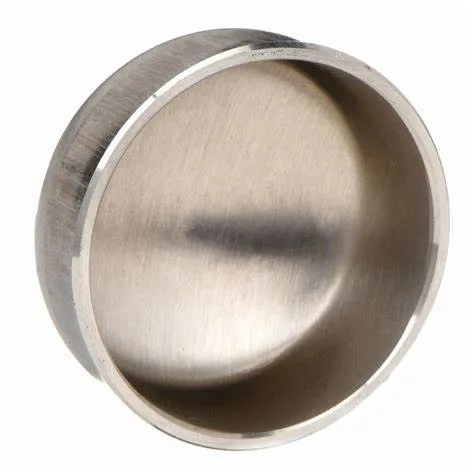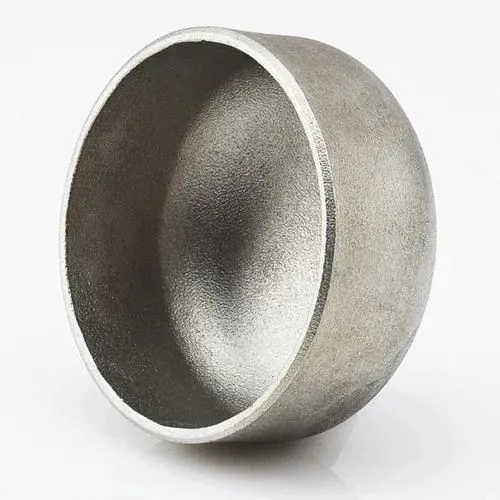JIS B2311 គឺជាស្តង់ដារឧស្សាហកម្មរបស់ប្រទេសជប៉ុន ដែលគ្របដណ្ដប់លើឧបករណ៍បំពង់ទុយោ រួមទាំងមួកដែលប្រើក្នុងប្រព័ន្ធបំពង់។ Butt-welding caps បម្រើគោលបំណងបិទចុងបំពង់ ផ្តល់ត្រាដើម្បីការពារការលេចធ្លាយ ឬការចម្លងរោគ។ នេះជាការណែនាំអំពីមួកសម្រាប់ភ្ជាប់គូទ JIS B2311៖
- 1. JIS B2311 Standard:
- - ស្តង់ដារ JIS B2311 បញ្ជាក់ពីតម្រូវការសម្រាប់ការរចនា វិមាត្រ សម្ភារៈ ការផលិត និងការធ្វើតេស្តឧបករណ៍ភ្ជាប់គូទ រួមទាំងមួកនៅក្នុងប្រព័ន្ធបំពង់។
- - ស្តង់ដារធានាថាមួកដែលផលិតដោយអនុលោមតាមស្តង់ដារ JIS បំពេញតាមស្តង់ដារគុណភាព និងត្រូវគ្នាជាមួយសមាសធាតុបំពង់ផ្សេងទៀត។
- 2. Butt-Welding Cap:
- - មួកផ្សារដែក យោងទៅតាម JIS B2311 គឺជាឧបករណ៍ដែលត្រូវបានរចនាឡើងដើម្បីបិទ និងបិទចុងបំពង់ដោយសុវត្ថិភាព ដោយផ្តល់នូវការការពារ និងរក្សាភាពសុចរិតនៃប្រព័ន្ធបំពង់។
- - មួកត្រូវបានប្រើក្នុងស្ថានភាពដែលចុងបំពង់តម្រូវឱ្យបិទជាអចិន្ត្រៃយ៍ ឬបណ្តោះអាសន្ន ដើម្បីការពារការលេចធ្លាយ ការចម្លងរោគ ឬដើម្បីផ្តល់នូវការបញ្ចប់ដល់ប្រព័ន្ធ។
- 3. សម្ភារៈ និងសំណង់៖
- - មួកផ្សារដែកក្រោមការបញ្ជាក់របស់ JIS B2311 មាននៅក្នុងសម្ភារៈផ្សេងៗដូចជា ដែកកាបូន ដែកអ៊ីណុក និងដែកយ៉ាន់ស្ព័រ ដើម្បីបំពេញតម្រូវការកម្មវិធីផ្សេងៗ។
- - មួកទាំងនេះត្រូវបានផលិតដោយប្រើវិធីសាស្ត្រសំណង់ស្តង់ដារ ដើម្បីធានាបាននូវការតភ្ជាប់ដ៏រឹងមាំ និងគ្មានការលេចធ្លាយនៅពេលភ្ជាប់ទៅចុងបំពង់។
- 4. កម្មវិធី និងអត្ថប្រយោជន៍៖
- - មួកផ្សារ Butt-welding ស្វែងរកកម្មវិធីនៅក្នុងឧស្សាហកម្មផ្សេងៗ រួមទាំងប្រេង និងឧស្ម័ន ដំណើរការគីមី រោងចក្រប្រព្រឹត្តកម្មទឹក និងច្រើនទៀតដែលចុងបញ្ចប់នៃបំពង់ត្រូវបិទដោយសុវត្ថិភាព។
- - មួកផ្តល់ការការពារដល់ចុងបំពង់ពីធាតុបរិស្ថាន ការពារការចម្លងរោគ និងជួយរក្សាភាពស្អាត និងសុចរិតភាពនៃប្រព័ន្ធបំពង់។
- 5. ការដំឡើងនិងការផ្សារ:
- - ការអនុវត្តការដំឡើងត្រឹមត្រូវ រួមទាំងការតម្រឹមត្រឹមត្រូវ ការរៀបចំចុងបំពង់ និងបច្ចេកទេសផ្សារ គឺជារឿងចាំបាច់នៅពេលដំឡើងមួកសម្រាប់ភ្ជាប់គូទ ដើម្បីធានាបាននូវភាពតឹងណែន និងការពារការលេចធ្លាយ។
- - ការផ្សារដែកគឺជាវិធីសាស្រ្តទូទៅសម្រាប់ការភ្ជាប់មួកទៅនឹងបំពង់ ផ្តល់នូវការបិទប្រកបដោយសុវត្ថិភាព និងជាអចិន្ត្រៃយ៍ដែលអាចទប់ទល់នឹងសម្ពាធ ការប្រែប្រួលសីតុណ្ហភាព និងលំហូរសារធាតុរាវនៅក្នុងប្រព័ន្ធ។
- សរុបមក មួកផ្សារដែក JIS B2311 គឺជាធាតុផ្សំដ៏សំខាន់ដែលប្រើក្នុងប្រព័ន្ធបំពង់ដើម្បីបិទ និងការពារចុងបំពង់ដោយសុវត្ថិភាព។ មួកទាំងនេះអនុលោមតាមតម្រូវការស្ដង់ដារដើម្បីធានាបាននូវគុណភាព ភាពជឿជាក់ និងភាពឆបគ្នានៅក្នុងកម្មវិធីឧស្សាហកម្ម ដែលការបិទបំពង់ និងការការពារគឺជាការចាំបាច់។
What Is a Butt Welding Cap and How Is It Used in Industrial Piping?
In industrial piping systems, end-of-line sealing and branch closures require robust solutions. A butt welding cap serves as a critical component for terminating pipes securely. By providing a seamless, welded closure, this fitting maintains system integrity, prevents leaks, and supports compliance with industry standards.
What Is a Butt Welding Cap?
A butt welding cap—also called a pipe end cap or buttweld end cap—is a round fitting designed to close off the end of a pipe. It’s manufactured to match the pipe’s outer diameter and schedule, with either a hemispherical or flat face. To install, both the pipe end and cap are beveled to form a V‑groove, enabling full‑penetration, fusion welds. Common materials include carbon steel, stainless steel, nickel alloys, and other engineered grades, chosen to satisfy pressure, temperature, and corrosion‑resistance requirements.
How Is Butt Welding Cap Used in Industrial Piping?
Butt welding caps find application across oil & gas, petrochemical, power generation, water treatment, and general process industries for both permanent and temporary closures. During hydrostatic testing, technicians install caps to seal off sections of piping while monitoring for leaks. In new construction or retrofit projects, caps terminate branch lines, future tie‑in spools, or dead‑end mains until system expansion. Welders prepare each joint by cleaning and beveling surfaces, aligning the cap precisely, and executing a root pass followed by filler passes per the qualified Welding Procedure Specification (WPS). Post‑weld heat treatment and non‑destructive examination (NDE)—such as radiography or ultrasonic testing—verify weld integrity and compliance with ASME B16.9 and related standards. Additionally, temporary caps enable safe isolation during maintenance, allowing for segment testing and dewatering under regulatory protocols.
Benefits and Best Practices
Butt welding caps offer a smooth‑bore transition that minimizes flow disruption and stress concentration. Their full‑penetration welds deliver exceptional structural strength and leak resistance. To optimize performance, engineers should:
Select caps with matching material grades and wall thicknesses
Adhere to proper bevel angles and joint fit‑up tolerances
Follow qualified WPS protocols rigorously
Consider cladding or protective coatings in corrosive environments to extend service life
Regular inspection and thorough documentation ensure long‑term reliability and safe operation under demanding conditions.
Butt welding caps are indispensable components for achieving durable, leak‑proof pipe terminations in a wide range of industrial applications.
Butt Welding Cap FAQs
What is a butt welding cap?
|
What materials are commonly used?
|
What standards govern butt welding caps?
|
How are butt welding caps installed?
|
Where are butt welding caps typically used?
|
What are the advantages of threaded caps?
|
















